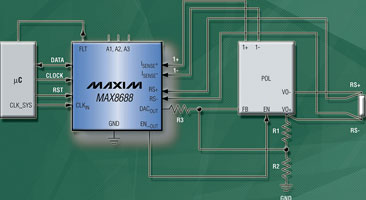

Maxim has introduced a chip to convert an all-analog power supply to a fully programmable, digital power-management solution. Believed to be a first, the MAX8688 is a complete digital power-supply controller/monitor that uses PMBus for communication, and can be used to control/monitor up to a total of 127 power supplies on a single bus.
The MAX8688 taps into existing analog power-management solutions to provide superior control and monitoring capabilities - all functionality previously only available in all-digital power supplies. Using 'PowerMind', the intelligence behind the company's new family of products, the MAX8688 provides many major benefits.
Performance applications demand digital
The electronics industry is expending considerable effort to go completely digital, as quickly as possible. The new requirements of high-performance systems like servers, switches, and routers force power supplies to have some intelligence. Intelligence can mean flexible monitoring, intelligent setting of warning and fault thresholds and fault handling, or microsecond resolution of timing events like tracking and sequencing. These high-performance applications also require a multitude of voltage rails on a given card or system. This presents difficult sequencing and tracking tasks, almost impossible in the analog domain. Additionally, monitoring and understanding the status of power supplies, up to now only possible with multiple discrete components, can dramatically improve system reliability and reduce downtime. Prior to the PowerMind technology, such intelligence in power management was either impossible, or only possible through completely digital, although still limited, power supplies.
Analog's transition to full digital eased
The MAX8688 facilitates the monitoring and control of the power supply by simply tapping into the existing, all-analog power supplies. It closes a slow loop around the power supply to bring high accuracy and control in setting the output voltage. By tapping into the enable, feedback node, and/or reference input, it provides tracking, sequencing, and fine setting of the output voltage down to ±0,2% accuracy over the operating temperature. With full control of the output, tasks like margining up or down and transitioning the output voltage at a controlled rate, are quite simple. The MAX8688 uses the accuracy of its integrated 12-bit, highly linear ADC to monitor output voltage, current, and on-board temperature. Consequently, multiple warning and fault thresholds are set and served with the flexibility of digital control.
In the PowerMind approach, a master microcontroller communicates to the MAX8688 through the PMBus. The system controller facilitates datalogging and system-level control. Although the IC holds all the power supplies' peak temperature, output current, and output voltage data, the system controller can poll each power supply at fixed intervals and log the information intelligently for future analysis. This provides often indispensable status and event information.
The MAX8688 can also modify the performance of the power supply remotely - another unique benefit of PowerMind. Too often, system integrators must rush designs without full evaluation and characterisation of the system before the first shipment. Engineering judgement thus replaces actual data, posing performance risks. A MAX8688 system can prevent field failures and potential recalls by simply allowing remote access to the unit for programming the output voltage down to 500 microvolt steps, and/or the sequencing, the tracking, and the fault/warning thresholds.
Current sharing between modules is also possible with the MAX8688 controller, because the system controller has both the information about the output current and full control of output voltage. By simply manipulating the output voltage of the slave module(s), the output current can be matched to that of the master module, regardless of the physical distance between the power supplies. This is generally a very difficult task, especially when the supplies are physically far apart.
The PowerMind approach with the MAX8688 keeps the PWM in the analog domain. This ensures the migration to digital remains as simple as possible with no new tricks, new compensation methods, or jittery output, all of which are commonly associated with digital PWM. Although some argue that digital PWMs provide higher efficiency, faster transient response, and lower EMI, no factual data supports this.
Easy-to-use software
Maxim supplies a graphical user interface (GUI) free of charge with the part. With no knowledge of digital control theory or how to write software/firmware, almost any engineer can use this GUI to implement a digitally programmable power supply. This is a great benefit to engineers and system integrators that do not want to discard legacy designs and risk a completely new architecture.
Using the company's MAXQ2000 microcontroller as a system controller, the GUI writes the necessary firmware, which can be loaded in the flash memory and run on the microcontroller. On power-up, the microcontroller loads the necessary register of the MAX8688 to work specifically as intended.
The user-programmable registers can also be stored in a low-cost, SOT23, 1 KB eeprom so that at power-up, the MAX8688 automatically fetches the data and loads the registers without requiring a system controller. This latter capability is particularly useful when controlling power in a module or in smaller systems without a system controller. Module manufacturers can load the MAX8688 with default values, which can then be over-written by the end-user.
The MAX8688 comes in a lead-free, 24-pin, 4 x 4 mm TQFN package. It operates over -40-85°C, requires a 3,3 V supply, and can control output voltages from 0 to 5,5 V.
| Tel: | +27 11 608 0070 |
| Email: | [email protected] |
| www: | www.cstelectronics.co.za |
| Articles: | More information and articles about CST Electronics |
| Tel: | +27 11 458 9000 |
| Email: | [email protected] |
| www: | www.electrocomp.co.za |
| Articles: | More information and articles about Electrocomp |
© Technews Publishing (Pty) Ltd | All Rights Reserved